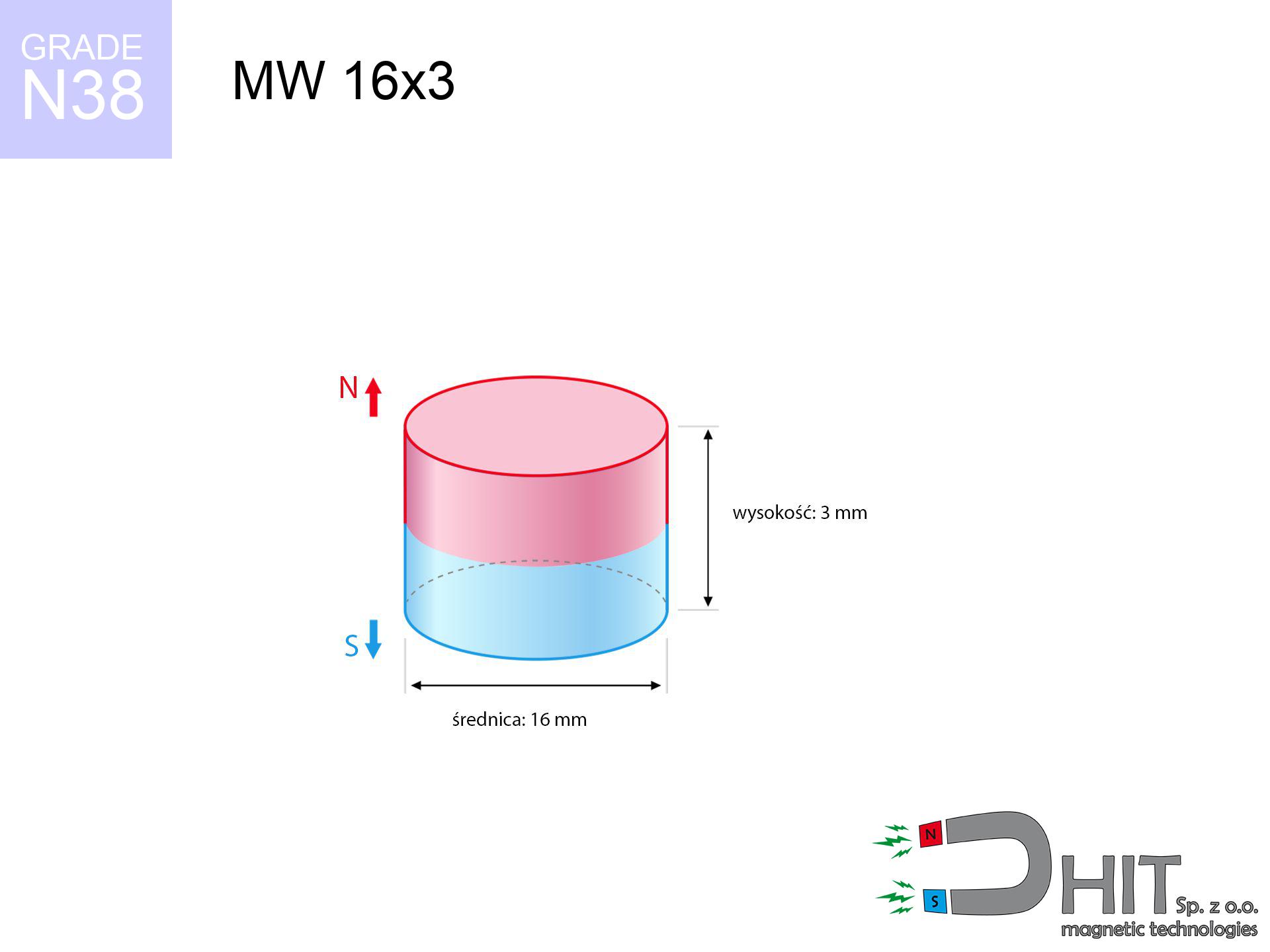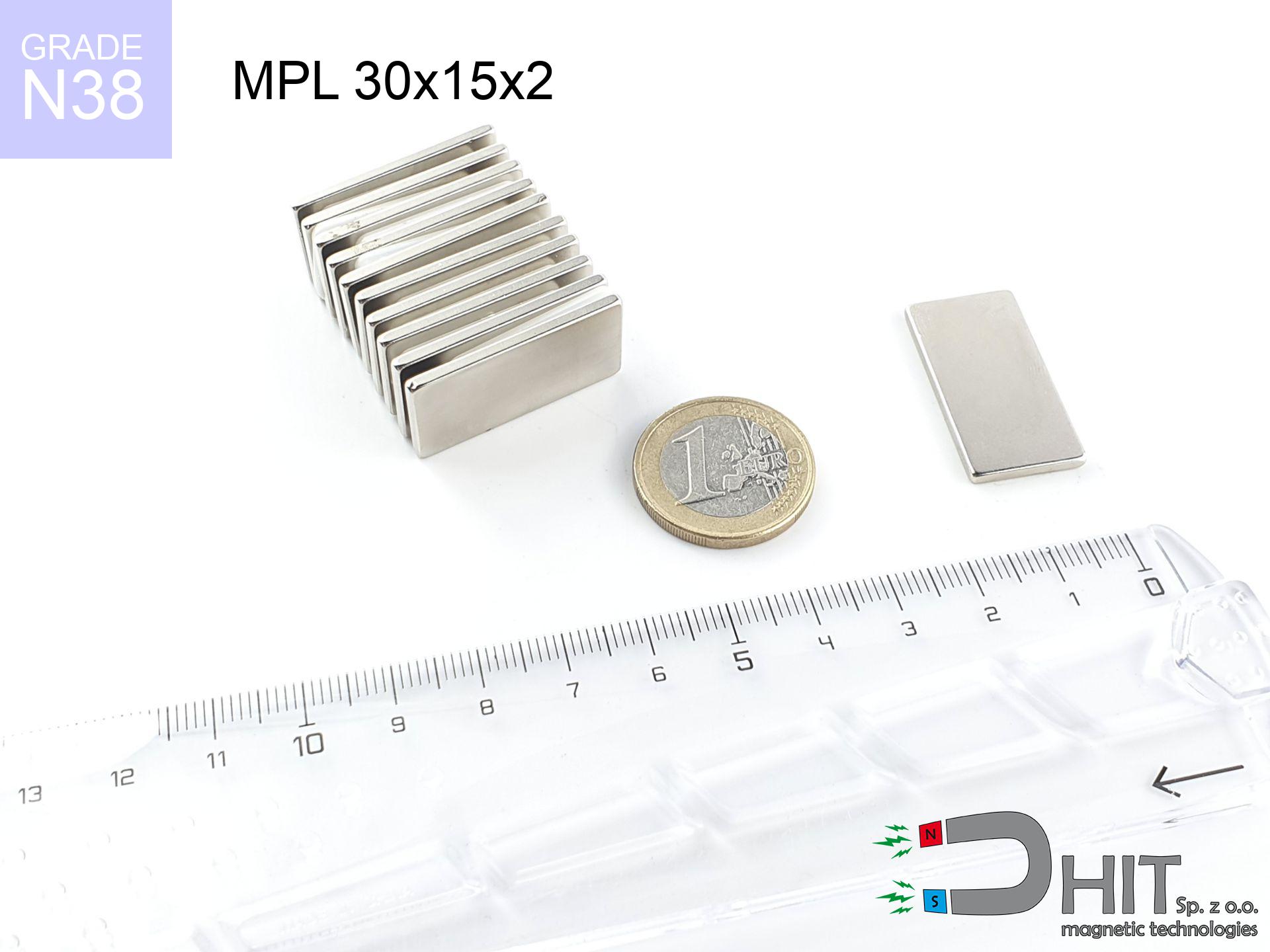MW 16x3 / N38 - cylindrical magnet
cylindrical magnet
Catalog no 010033
GTIN: 5906301810322
Diameter Ø [±0,1 mm]
16 mm
Height [±0,1 mm]
3 mm
Weight
4.52 g
Magnetization Direction
↑ axial
Load capacity
2.65 kg / 25.99 N
Magnetic Induction
217.61 mT
Coating
[NiCuNi] nickel
1.734 ZŁ with VAT / pcs + price for transport
1.410 ZŁ net + 23% VAT / pcs
bulk discounts:
Need more?Need help making a decision?
Call us
+48 888 99 98 98
alternatively drop us a message using
inquiry form
our website.
Parameters along with structure of a neodymium magnet can be verified with our
magnetic mass calculator.
Orders placed before 14:00 will be shipped the same business day.
Magnetic properties of material N38
Physical properties of sintered neodymium magnets Nd2Fe14B at 20°C
Shopping tips
Strengths as well as weaknesses of rare earth magnets.
Besides their high retention, neodymium magnets are valued for these benefits:
- They virtually do not lose strength, because even after ten years the decline in efficiency is only ~1% (according to literature),
- They are extremely resistant to demagnetization induced by external disturbances,
- By covering with a smooth layer of silver, the element has an professional look,
- They show high magnetic induction at the operating surface, which affects their effectiveness,
- Due to their durability and thermal resistance, neodymium magnets can operate (depending on the shape) even at high temperatures reaching 230°C or more...
- Due to the potential of accurate shaping and adaptation to custom needs, NdFeB magnets can be modeled in a broad palette of forms and dimensions, which increases their versatility,
- Wide application in modern industrial fields – they are utilized in mass storage devices, brushless drives, diagnostic systems, and complex engineering applications.
- Thanks to their power density, small magnets offer high operating force, with minimal size,
Characteristics of disadvantages of neodymium magnets and ways of using them
- They are fragile upon too strong impacts. To avoid cracks, it is worth protecting magnets using a steel holder. Such protection not only shields the magnet but also improves its resistance to damage
- When exposed to high temperature, neodymium magnets experience a drop in strength. Often, when the temperature exceeds 80°C, their strength decreases (depending on the size and shape of the magnet). For those who need magnets for extreme conditions, we offer [AH] versions withstanding up to 230°C
- Magnets exposed to a humid environment can corrode. Therefore while using outdoors, we recommend using waterproof magnets made of rubber, plastic or other material protecting against moisture
- Limited ability of creating threads in the magnet and complicated shapes - recommended is cover - mounting mechanism.
- Health risk resulting from small fragments of magnets are risky, when accidentally swallowed, which is particularly important in the context of child safety. Additionally, small components of these devices can disrupt the diagnostic process medical when they are in the body.
- With budget limitations the cost of neodymium magnets is economically unviable,
Maximum magnetic pulling force – what it depends on?
The load parameter shown concerns the limit force, recorded under optimal environment, namely:
- using a base made of mild steel, functioning as a circuit closing element
- with a thickness minimum 10 mm
- characterized by lack of roughness
- with total lack of distance (without impurities)
- during pulling in a direction vertical to the mounting surface
- at conditions approx. 20°C
Practical lifting capacity: influencing factors
Holding efficiency is affected by working environment parameters, including (from priority):
- Air gap (betwixt the magnet and the metal), since even a tiny clearance (e.g. 0.5 mm) results in a reduction in lifting capacity by up to 50% (this also applies to varnish, rust or debris).
- Force direction – remember that the magnet has greatest strength perpendicularly. Under sliding down, the capacity drops drastically, often to levels of 20-30% of the nominal value.
- Plate thickness – insufficiently thick sheet does not close the flux, causing part of the power to be escaped to the other side.
- Material composition – different alloys reacts the same. Alloy additives weaken the interaction with the magnet.
- Smoothness – ideal contact is obtained only on smooth steel. Any scratches and bumps reduce the real contact area, reducing force.
- Heat – NdFeB sinters have a sensitivity to temperature. When it is hot they lose power, and in frost they can be stronger (up to a certain limit).
* Lifting capacity testing was conducted on a smooth plate of optimal thickness, under a perpendicular pulling force, whereas under parallel forces the load capacity is reduced by as much as 5 times. Additionally, even a slight gap {between} the magnet and the plate decreases the holding force.
Safe handling of neodymium magnets
Keep away from electronics
Remember: rare earth magnets generate a field that interferes with sensitive sensors. Keep a separation from your mobile, device, and navigation systems.
Caution required
Exercise caution. Rare earth magnets act from a distance and snap with huge force, often faster than you can react.
Danger to pacemakers
Health Alert: Neodymium magnets can deactivate heart devices and defibrillators. Stay away if you have electronic implants.
Serious injuries
Big blocks can break fingers in a fraction of a second. Under no circumstances put your hand betwixt two strong magnets.
Shattering risk
Despite metallic appearance, the material is brittle and not impact-resistant. Do not hit, as the magnet may crumble into sharp, dangerous pieces.
Heat sensitivity
Keep cool. NdFeB magnets are susceptible to temperature. If you need operation above 80°C, inquire about HT versions (H, SH, UH).
No play value
Strictly store magnets out of reach of children. Choking hazard is high, and the effects of magnets clamping inside the body are fatal.
Allergy Warning
Allergy Notice: The nickel-copper-nickel coating contains nickel. If redness appears, cease working with magnets and use protective gear.
Electronic hazard
Do not bring magnets near a wallet, computer, or TV. The magnetic field can permanently damage these devices and erase data from cards.
Dust explosion hazard
Mechanical processing of NdFeB material carries a risk of fire risk. Neodymium dust reacts violently with oxygen and is hard to extinguish.
Important!
Need more info? Check our post: Are neodymium magnets dangerous?







![SM 32x350 [2xM8] / N52 - magnetic separator SM 32x350 [2xM8] / N52 - magnetic separator](https://cdn3.dhit.pl/graphics/products/sm-32x350-2xm8-fag.jpg)

